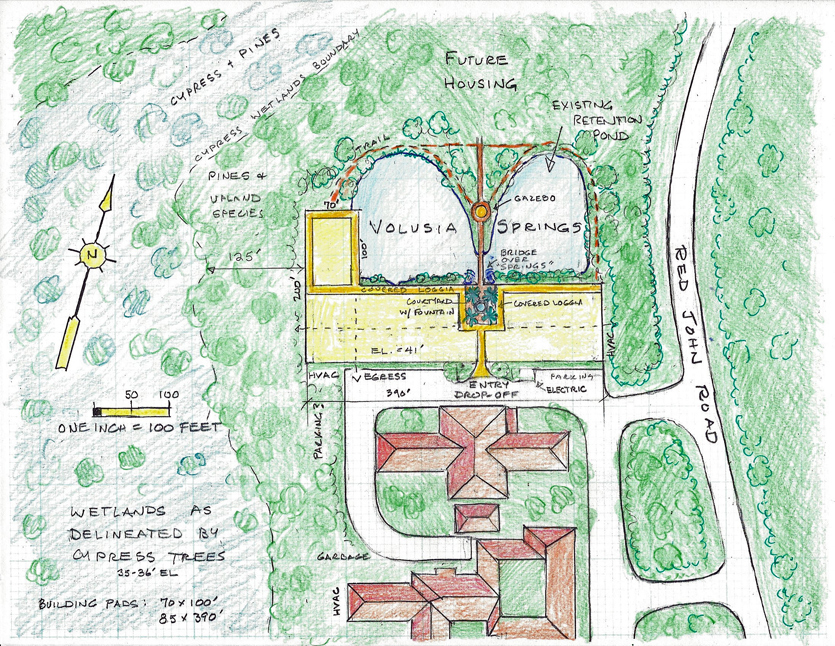Doing Good by the Homeless While Saving Money with a Proven Plan
by Michael E. Arth, 11-20-14
In late 2007, some of us seeking to remedy chronic adult homeless in Volusia County proposed Tiger Bay Village, an entirely voluntary, holistic, transformational campus of services next door to Stewart Marchman Act (SMA) near the county jail. The plan was later endorsed by H.O.M.E., Volusia’s organization of homeless persons and went through three county reviews. Eight, long, contentious years later, a scaled-down version, now known as Volusia Safe Harbor or Volusia Springs, was finally endorsed by our local Continuum of Care in preparation for approval by the county council. As a county-wide solution with costs and benefits shared by all county residents, Volusia Springs will be able to grow in this location as savings are realized and additional funds are procured.
Once all the existing costs of jail, prison, police, fire department, street maintenance, 476 Volusia social service agencies, and other private and public costs are added up, it is clear we are squandering a fortune to ensure the homeless, the mentally ill, and substance abusers stay in dependent misery. The City Commission of Daytona Beach, fed up with being a dumping ground for problems not being solved by the rest of the county or the competing agencies, finally hired an outside consultant named Dr. Robert Marbut to come up with a practical solution. In San Antonio, Marbut won the cooperation of 85 agencies and was able to build and operate a holistic, transformational campus of services on 33 acres that essentially solved that city’s homeless-related problems. San Antonio Mayor Julián Castro’s help in getting it done caught national attention, and Castro was appointed by the Senate this year as the new secretary of HUD.
The U.S. has the highest incarceration rate in the world, largely due to the practice of putting drug users and the mentally ill in prison instead of using much more pragmatic and compassionate treatment and housing programs that benefit society and reduce costs. We also suffer the highest health care costs and the highest homelessness rates of any industrialized country. Texas, one of the most conservative states, has adopted the holistic, campus of services model because it gets the job done for less. It also happens to be compassionate and gives clients their dignity along with attainable goals. Marbut has proposed a number of such campuses across the country where a range of complicated issues and services can be handled in one place for maximum benefit and minimum cost. Marbut affirmed what we have been saying for years: the site next to SMA “is the only logical location” for such a campus in Volusia County. It’s time for logic to be transformed into action.
The dream of a village, a community, will not be entirely realized with the first building. All journeys begin with one step. The first step is the creation of Volusia Springs (aka Volusia Safe Harbor), which would be adjacent to the Stewart Marchman Act detox and mental health facility on Red John Road at highway 92, 11 miles east of DeLand and 11 miles west of the ocean at Daytona Beach. Dr. Marbut proposed in his recommendations the first buildings should be built on the west side of SMA. The west side of SMA is not feasible, however because it is a cypress wetlands. Therefore, as shown in the illustration, the location has been moved to the north side of SMA, which not only has a graded pad, but an existing pond and additional water features, which can be incorporated into the plan. The central walkway would pass from the entry through the building into the courtyard with a central fountain. The walkway would cross a bridge with views of the waterfalls and lead to a gazebo. From there, the path would lead into the woods where permanent housing could also be built later. All of these things, in a tranquil setting, will help create an atmosphere conducive to rehab and healing.

The proposed site for Volusia Springs (shown in yellow) is immediately north of Stewart Marchman Act off 92 on pine upland that is already partially cleared and graded. An existing retention pond and a second pond would be added to create a conjoined water feature utilizing waterfalls and a courtyard with a small fountain incorporated into a 200-bed facility designed pro-bono by architect Bill Chapin. This site allows for further expansion and permanent housing, which would eventually comprise a truly holistic, community of services.